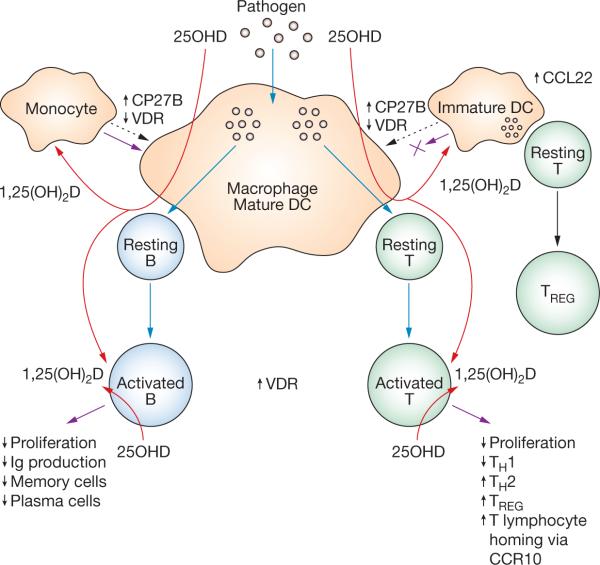Figure 2.
Vitamin D, antigen presentation and adaptive immunity. Macrophages and mature DCs can induce both adaptive T-lymphocyte-mediated and B-lymphocyte-mediated immunity by internalizing and processing pathogens. Presentation of the resulting antigens to resting B lymphocytes or resting T lymphocytes leads to the activation of these cells and concomitant adaptive immune response (blue arrows). Macrophages and mature DCs also express the vitamin-D-activating enzyme CP27B and are thus able to synthesize 1,25(OH)2D from precursor 25OHD (red arrows). The 1,25(OH)2D synthesized in this way can act in a paracrine fashion on activated B lymphocytes and activated T lymphocytes, which express abundant VDR; local effects of 1,25(OH)2D are designated by purple arrows. The effects on B and T lymphocyte function are listed. Additional paracrine responses to 1,25(OH)2D also seem to be manifested via precursor monocytes and immature DCs, which express higher levels of VDR than their mature counterparts. In the case of monocytes, 1,25(OH)2D seems to stimulate further differentiation of macrophages (purple arrow at the upper left), possibly as an adjunct to the effects of vitamin D on innate immunity (see Figure 1). By contrast, 1,25(OH)2D suppresses DC maturation (blocked purple arrow at the upper right), providing a mechanism for attenuation of adaptive T lymphocyte responses coupled with enhancement of immunosuppression mediated by TREG. Abbreviations: 1,25(OH)2D, 1,25-dihydroxyvitamin D; 25OHD, 25-hydroxyvitamin D; CCL22, CC-chemokine ligand 22; CCR10, CC-chemokine receptor 10; CP27B, 25OHD-1α hydroxylase; DC, dendritic cell; Ig, immunoglobulin; TH1, type 1 T-helper lymphocyte; TH2, type 2 T-helper lymphocyte; TREG, T-regulatory lymphocyte; VDR, vitamin D receptor.

